CODES OF POSITION AMIDST THE XI'AN COMPLEX OF PYRAMIDS AND MOUNDS
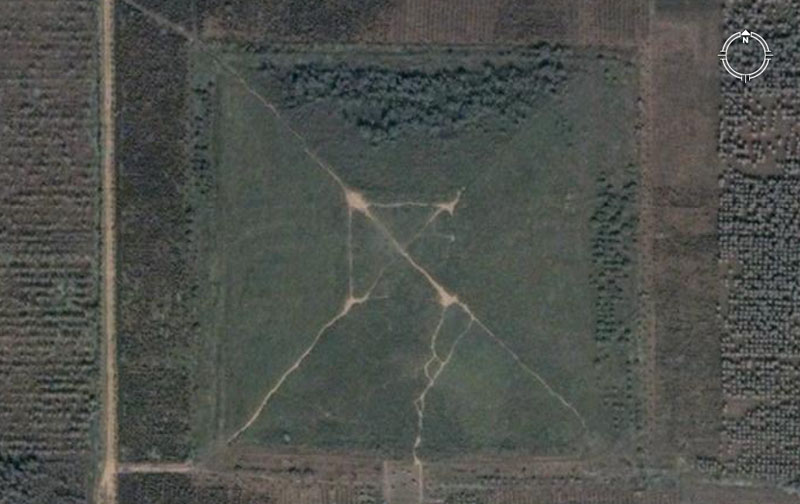
This is the largest pyramid of the XI'an complex and acted as the main hub or surveying position for the layout of all other pyramids, mounds or concentric embankment rings in the area. This pyramid was so situated as to have far off outer markers (fix-points) that sat perfectly North (a bluff) and South (a mountain peak), which acted as surveying benchmarks.
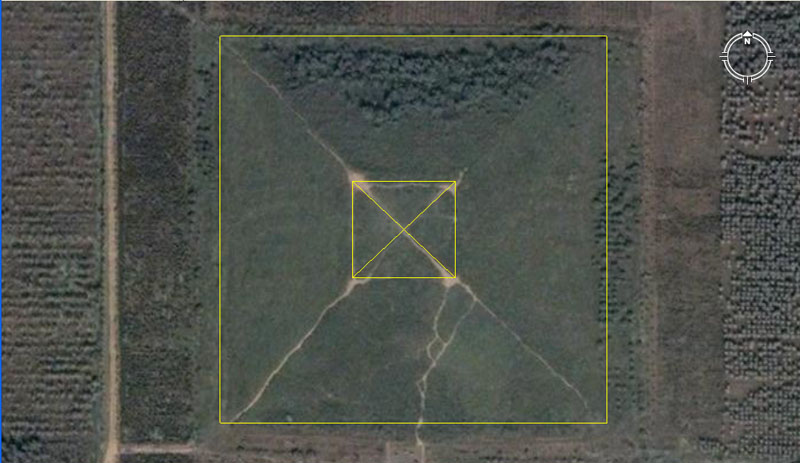
Here is the same pyramid with the precisely overlaid AutoCAD lines demarcating the apparent perimeter limits. This pyramid and others of the same complex were all orientated onto the primary points of the compass. The visual evidence suggests that this largest pyramid was square (although each side bows inwards in a slight curve, just like the pyramids of the Giza Plateau of Egypt), with sides of 540' each, giving the base a square footage of 291600 sq'. The top, flat floor section appears to have been 144' square, giving an area of 20736 sq'. The inwards curve of the sides would have accentuated shadow play and acted something like a sun dial (giving shadow readings) as the annual sun moved between its Summer & Winter Solstice positions.
Here are the apparent codes for its base dimensions:
The distance around the base (2160' ... 540' X 4) is a very useful lunar and Precession of the Equinoxes value. The sun spends 2160-years in each house of the zodiac during the 25920-year duration of the Precession of the Equinoxes. The evidence would suggest that the original bushel of England was 2160 cubic inches or 1/10th of a Babylonian Homer. The value 54 was very useful for calculating and tracking lunar cycle durations. For example, there would be 126 intervals of 54-days in the 6804-day lunar nutation cycle.
BABYLONIAN CAPACITY.
1 Archane…… 129600 cubic
inches, equals:
6 Homer…… @ 21600 cubic inches, or
36 Artaba….. @ 3600 cubic inches, or
216 Sutu…… @ 600 cubic inches, or
2160 Qa……. @ 60 cubic inches.
The area covered by the pyramid (291600 square feet... accentuating 2916) is a coded value that works in a mathematical progression related to the equatorial circumference of the Earth, under the literal system encoded into the base dimensions of the Great Pyramid of Egypt. Also, the Roman "lunar" foot, used for calculations to do with the lunar cycles was 11.664-inches and their "pace" was five Roman feet or 58.32" (29.16" X 2).
If we knew the official, finished heights of these pyramids then we could work out the intended slope angles, which would be code-bearing as well. The flat top of this pyramid appears to measure 144' X 144' or 20736 square feet. The largest Egyptian cubit found by Petrie was 20.736" and this highly factorable value surfaces continuously in ancient the metrology standards of the much scattered, migrant Caucasian civilisations.
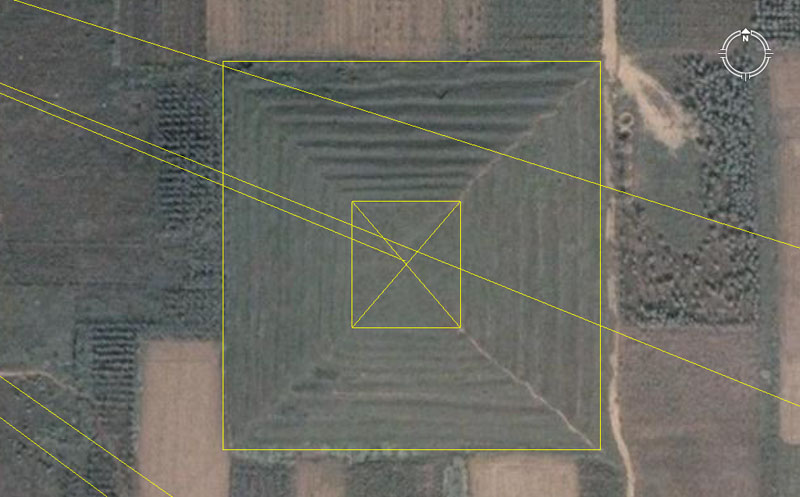
The distance from the main hub pyramid to this second pyramid appears to be 1890' at an azimuth angle of 112.5-degrees. This pyramid is rectangular, with dimensions that appear to be 472.5' east-west and 486' north-south. It is also a stepped pyramid, which means that every rising terrace would also have been coded by way of length and breadth.
With a distance from the main pyramid of 1890' at an azimuth angle of 112.5° the codes are:
1. The distance is navigational and lunar cycle coding simultaneously. The Great Pyramid of Egypt is 756' long and 189' equates to 1/4th of that length. In other words, this distance at XI'an is exactly 21/2 times the length of the Great Pyramid. This length also represents 3.2-minutes of Earth equatorial arc, according to the geodetic system built into the base dimensions of the Great Pyramid, where two circumnavigations (6048') represents 1-minute of arc.
The value of 1890-days was used on the Calendar of Coligny, a brass plaque found in France, for following both the sun and the moon within the confines of a lunisolar Sabbatical Calendar. The plaque was made up of 128 half squares representing either lunar of solar months. Two sections (squares) were CIALLOS or intercalary and either one or two of these could be pressed into service, depending upon whether one was doing lunar or solar calculations The count was either, 1890-days ÷ 63 = 30 (the number of days in a solar month) or 1890 ÷ 64 = 29.53125-days (2917/32nds ... the number of days in a lunar month to a tolerance of under 1-minute).
The 1890-day count on the Calendar of Coligny could then be applied to both the 6804-day lunar nutation cycle (36 X189) and the 2551.5-day count (7.2 lunar years) monitored alongside 7-solar years (2556.75-days) in the lunisolar Sabbatical Calendar system. Therefore: 2551.5-days = 13.5 X 189.
2. The azimuth angle of 112.5° is accentuating a secondary angle within the 360° system. The sum of 11.25° would be 1/32nd of 360°. The progression goes: 0/360, 11.25, 22.5, 33.75, 45, 56.25, 67.5, 78.75, 90, 101.25, 112.5, etc. This same angle code was used between the centre positions of Stonehenge and an outer appendage stone circle site called Bluestonehenge.
3. If the dimensions @ 472.5' X 486' prove to be correct after a proper archaeological survey has taken place, then the 472.5' component is lunar coding and the 486' component is navigational and lunar coding simultaneously. The Khafre Pyramid of Egypt was built by a 3,4,5 triangle method, wherein half the base length is 354.375' (the number of days in a lunar year or 12 lunar months); the height is 472.5' (in days this would be 16 lunar months); the diagonal slope is 590.625' (in days this would be 20 lunar months). The slope angle of the Khafre Pyramid is 53.130°, consistent with that of a 3,4,5 triangle.
The Calendar of Coligny brass plaque is 4.86' long (58.32" or 1 Roman lunar Pace). The 6804-day duration of the lunar nutation cycle is 486 intervals of 14-days (2-weeks). The 2551.5-day lunar period monitored within the Sabbatical Calendar is 486 X 5.25-days. Note: The Hebrew half-reed was 5.25' , the Greek short stadia was 525' and the Greek mile was 5250'.
Let's discuss other codes of the largest grouping. Batch number 1.
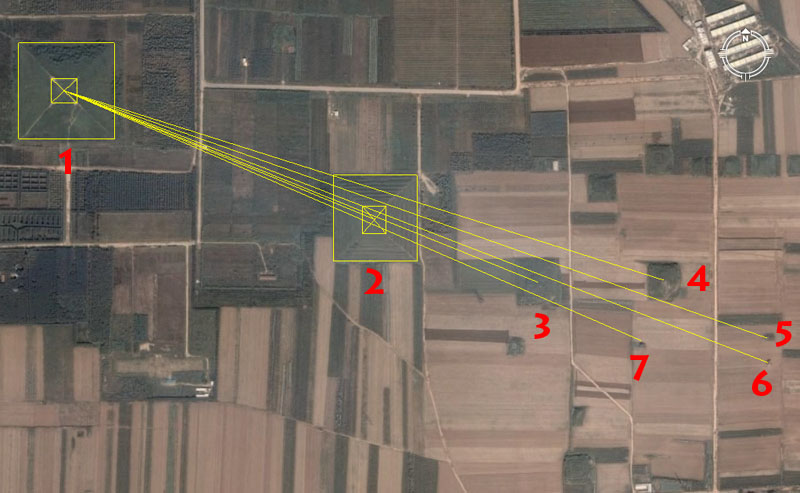
Pyramids 1 & 2 have been discussed.
Pyramid 3. This pyramid is covered in tree growth and it's difficult to get a reliable fix on its corner positions, sufficient to measure it.
It sits 2880' from the main pyramid at an azimuth angle of 112°.
The value 288 is one of the most used and dynamic factorable numbers of antiquity and was pressed into service for navigational, lunar and Precession of the Equinoxes calculations. It was also a base value in the Egyptian Pyramid Acre (28800 square feet) or the Geomancer's mile of ancient Britain (14400'). The sum of 288-years would be 1/90th of the duration of the Precession of the Equinoxes. The Aubrey Circle at Stonehenge is 288' wide.
The azimuth angle value, 112°, is navigational coding. The length of 1-second of Earth equatorial arc under the Egyptian and Greek systems was 100.8' or 9 X 11.2'. A distance of 112' would be 1/54th of 1-minute of equatorial arc. Progressions based upon 112 were pressed into service for the British weights standard, thus a CWT (hundredweight) is 112-lbs (pounds) and a ton (20 CWT) is 2240-lbs, etc. These British weights were related by direct ratio to early epoch Egyptian weights. This system of weights has survived in the ounce, pound, stone, cwt and ton standard of the United States and was only recently, forcibly removed from Britain by metrification.
Pyramid 4. Again, this structures is quite wrecked, so that the base dimensions are largely indefinable within Google Earth.
The high point of the structure appears to be coding 3543.75' distance from the centre of the main pyramid, at an azimuth angle of 108° or 288° return to the main pyramid.
The distance is, of course, coding the lunar year @ 354.375-days (3753/8ths).
The value 108 is, again, a much used factorable number of antiquity for navigational calculations and also to describe the duration of the Precession of the Equinoxes. The Great Pyramid @ 756' equates to 7 X 108'. In the 25920-year cycle of Precession the sum of 108-years would be 1/240th of the cycle.
Pyramid 5.
This pyramid, or what little is left of it, appears to be 4200' from the main pyramid, at an azimuth angle of 109.375°.
The number 42 (6 X 7) was the base value for, what has come to be known as, the ancient Greek measurement system. This same "6&7" system is found encoded into the English landscapes around Avebury Henge and Stonehenge thousands of years before there were any Greeks. Under this system a mile is 5250', a stadia is 630', a short stadia is 525', a reed is 10.5' and a foot is 12.6".
The azimuth angle of 109.375° is strong lunar and navigational coding simultaneously. The value could be used in a mathematical progression to generate many important lunar and navigational numbers. The sum of 109.375' would be 1/48th of a Greek mile of 5250'.
Pyramid 6.
This pyramid has been badly excavated into and brutalised. It appears to have originally carried the coded length of 4252.5' from the main pyramid at an azimuth angle of 111.375°.
The length value is lunar coding and the sum of 425.25-days would be 1/16th part of the of the 6804-day lunar nutation cycle. Such values were very important when tracking the lunar nutation cycle within a calibrated circle. Even our 360° circles work very effectively and traditionally to 32 subdivided positions.
Given the condition of the structure and the difficulty encountered in establishing the epicentre, it's highly likely that the original degree angle was 111.375. This value is part of a mathematical progression that relates to the equatorial circumference of the Earth
Pyramid 7.
This pyramid sits 3543.75' from the main pyramid at an azimuth angle of 113.4°.
Again, the distance codes the lunar year value of 354.375. The azimuth angle also contains a dynamic lunar code and a mathematical progression based upon 1134 will deliver up many highly important lunar numbers. For example, the sum of 1134-days would be 1/6th of the 6804-day lunar nutation cycle. Also, there would be 22.5 instances of 113.4-days in the 2551.5-day lunar period (7.2 lunar years) monitored within the Sabbatical Calendar system. This, therefore, would mean that the lunar periods could be tracked within a 360° circle, as 22.5° is 1/16th of 360°.
Greek historian Herodotus was told by Egyptian priests that the Great Pyramid as 800-feet per side. We know that there were many kinds of "feet" and "cubits" in use in ancient times and all were based upon the same inch, as well as being ratio expressions of each other. The Great Pyramid at 756' of 12" each was also 800' of 11.34" each*. Three sides of the Great Pyramid = 2268' or 1134' X 2. By using this foot on the Great Pyramid's base perimeter, it worked effectively as a lunar cycle calculator.
*Footnote: Below is an example of early Germanic lengths, based upon the Flemish system, that were in use in the 13th century AD and prior. The values given in metres are taken from "official" or expert literature and show only very small drift off the original, precise increments of more remote antiquity.
ALT KULMISCHE MASZ
1 Meile = 1800 Ruten ... 7777.24 Metres (this equals 25515' to a tolerance of 10.5" in 4.86 Greek miles of 5250' each. It is very obvious that this ancient Germanic/ Flemish/ Prussian system was fully founded on, what's come to be known as, the Greek-mile system).
1 Rute = 15 Schuh ... 4.3218 Metres (the Rute, which was in direct ratio to the Meile, was 14.175'. The Khafre Pyramid of Egypt, which was a "pyramid of the moon" accentuating the lunar cycle periods, was 2835' in perimeter value or 200 Ruten).
1 Schuh = 0.28812 Metre (The Schuh, of which 15 made up 1-Rute, was .945' or 11.34"). This was the increment of length that Greek Historian Herodotus was told about by Egyptian priests, who stated that the Great Pyramid was 800-feet long ... Therefore: 756'÷ 800 = 11.34". By using a rule of this length, the Great Pyramid base perimeter could give lunar cycle readings. Three side lengths of the Great Pyramid @ 756' per side = 2268' or 1134' X 2. The Great Pyramid is 3200-Schuh in perimeter and the Khafre Pyramid is 3000-Schuh.
1 Elle = 2 Schuh 0.57624 Metre (The Elle was 22.68" and there would be 1200-Elle in three base side lengths of the Great Pyramid). Alternatively, the width of the Station Stone's Rectangle at Stonehenge was 113.4' or 60 Elle).
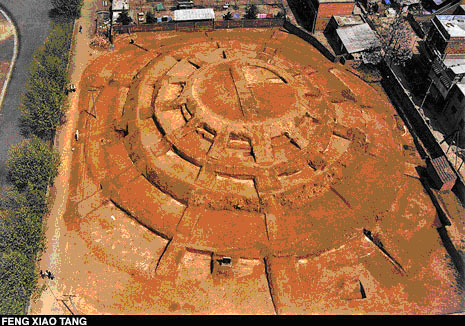
As so often happens, the original meaning of things can be lost to later generations. The base diameter of the XI'an Altar of Heaven, uncovered, measured, then reburied in the year 2000 (for its own protection), probably contains a code for the lunar year. It was officially measured to have a diameter of 177'. If this was, in fact, 177.1875' (21/4"longer), then it would be the half value of 354.375 (the number of days in a lunar year) and also quarter the length of the Khafre Pyramid of Egypt.
The structure was also measured to be 26' high and 26-weeks = half a year under the traditional 52-week count. The top floor section was 65' in diameter (half of 130' and again accentuating the "13" progression). Ancient agrarian peasant societies, for simplicity, divided their year into 13-months of 28-days each, with nine intercalary days added for correction at the end of the Sabbatical Year (7th solar year) Their scientists, however, engaged in tracking both the sun and moon's positions on a daily basis, divided the sky and annual cycles into 12-parts. The XI'an Altar of Heaven is divided into the 12 houses of the zodiac or constellations of the ecliptic.
Arkaim dual circle complex (the Russian Stonehenge ... 52° 37' 37" N - 59° 33' 40" E) situated 2700-miles to the northwest of XI'an's Altar of Heaven, carries the same lunar coding (albeit in enlarged ratio) in the diameter of its inner circle.
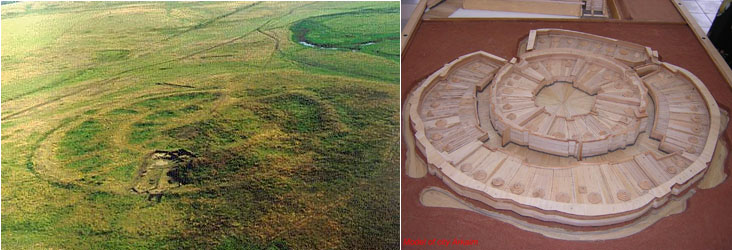
The inner circle of Arkaim is very slightly elliptical and officially measures 80 metres in one cross measure, but 84.6 metres at a point 90-degrees opposed. This cultural preoccupation of deliberately making circles slightly elliptical to create two different coded readings in the diameters, is found on many ancient British sites, including Stonehenge's Sarsen Circle and the two 90-degrees opposed cross measures of Silbury Hill's base.
So what do these diameters mean and how does one of them relate to the diameter of XI'an's Altar of Heaven, as well as the Flemish Rute measurement?
1. The cross measure of 80-metres easily translates to 262.5' (1/20th of a Greek mile or 250 Greek feet @ 12.6" each).
2. The cross measure of 86.4 metres easily translates to 283.5' (1/10th of the full perimeter distance around the Khafre Pyramid of Egypt). This same distance would be 20 Flemish Ruten, 27 Hebrew Reeds, 135 Assyrian Cubits, 270 Greek feet, etc.
In both cross measures the codes are lunar & navigational simultaneously. Careful measurements undertaken by archaeologists at Arkaim established that the primary measurement increment used was in the very near vicinity of 80 centimetres. This easily translates to 2.625' or 31.5", which is 2.5 so-called Greek feet of 12.6" each. The base increment of measurement found at Arkaim is, therefore, exactly 1/2000ths of a Greek mile, 1/240th of a Greek Stadia (630') or 1/200th of a Greek short Stadia (525"). This selfsame measurement standard was used extensively by European Caucasoid cousin nations since remote antiquity and is easily extracted from complexes like Avebury Henge or Stonehenge, which were built 2000-years or so before there was a Greek civilisation.
The 283.5' cross measurement of Arkaim's internal circle is in a ratio of 1.6 : 1 to the cross measurement of XI'an's Altar of Heaven and both contain the same lunar cycle codes.
One scientific article states: 'The external wall, 160 m in diameter and 4 m wide, was built from specially selected soil that had been packed into timber frames before being faced with adobe bricks' (Zdanovich 1997).
The distance of 160 metres translates easily to 525' or one Greek short Stadia (1/10th of a Greek mile). If the article is stating that the top of the wall then extended outwards for another 4 metres, then the distance across the entire complex, outer-wall-face to outer-wall-face, would have achieved very close to 550'.
These two measurements (525' & 550') were built into the 90-degrees opposed cross diameters of Silbury Hill's base, in Southern England. The measurements relate to the two systems of navigation commonly used by the very mobilised Caucasian-Aryan nations of remote antiquity. One system was based upon the numbers "6&7" combined (the Greek mile) and the other system was based upon the number "11" (the British mile). These two systems are very clearly marked into the terrain at XI'an's pyramid & mound complex.
Now the codes of batch number 2.
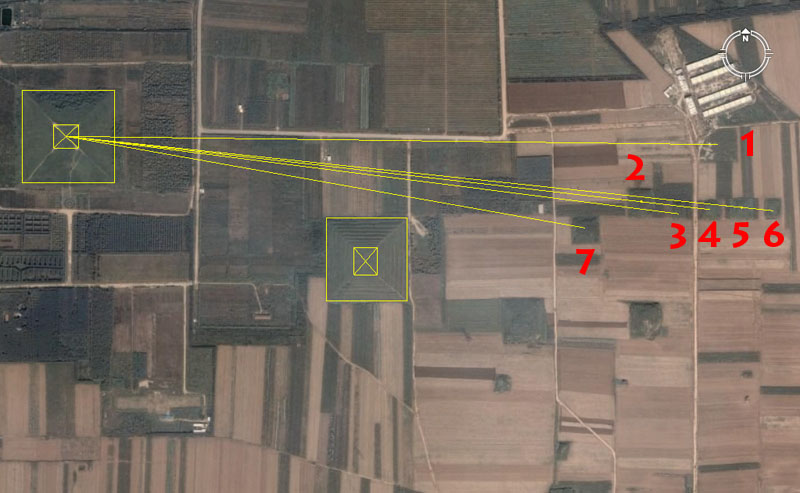
We now move to a grouping of pyramids further to the northeast.
1. There might be the ancient remnants of a pyramid here. It doesn't show up on the 1976 satellite photo, but there seems to be some vague indications of a former structure in the Google Earth image.
2. This structure sits 3375' from the main pyramid's top at a return angle of 276.48° (27612/25ths).
The 3375 value is both lunar and compass (360° circuit) coding simultaneously and 337.5° would be 15/16ths of 360°.
The degree angle is navigational coding and the sum of 276.48-miles would be 1/90th part of the 24883.2-mile (12 X 12 X 12 X 12 X 1.2) equatorial circumference.
3. This pyramid sits 3600' from the main pyramid's surveying platform. The azimuth angle was probably set at 97.2°, but because of heavy bush cover the exact epicentre is now difficult to determine.
The distance is, of course coding the 360° system.
The value 97.2 is a dynamic navigational value related to the equatorial circumference of the Earth and the sum of 97.2-miles would be 1/256th of the 24883.2 equatorial circumference. As in other examples shown already, this kind of calibration is for dividing up the Earth into 1/2, 1/4, 1/8, 1/16, 1/32, 1/64, 1/128, 1/256, etc., parts.
4. This pyramid sat 3780' out at a return angle of 276.48°.
This distance is 5-times the length of the Great Pyramid or 5/8ths of 1-minute of equatorial arc.
As stated, the 276.48 value relates to the 24883.2-mile equatorial circumference and how to calibrate it within a 360° circuit.
5. This pyramid sat 3960' out at an azimuth angle of 96°.
The length is in homage to the diameter of the Earth (7920-miles), of which 3960-miles would be the radius.
The degree angle value sets up a mathematical progression related to navigation, the equatorial circumference of the Earth, calculations related to the Precession of the Equinoxes as well as lunar cycles. For example, the 6804-day lunar nutation cycle is 19.2 lunar years (2 X 9.6).
6. This pyramid sat 4147.2' out at an azimuth angle of 96°.
The distance is coding the equatorial circumference of the Earth and 4147.2-miles would be 1/6th of the 24883,2-mile circumference.
7. This pyramid sat 3072' out at an azimuth angle of 100°.
The length is navigational and relates to the equatorial circumference of the Earth. The sum of 3072-miles would be 1/81st (9 X 9) part of the 24883.2-mile equatorial circumference.
The degree angle is accentuating base ten in the counting system.
Now the codes of batch number 3.
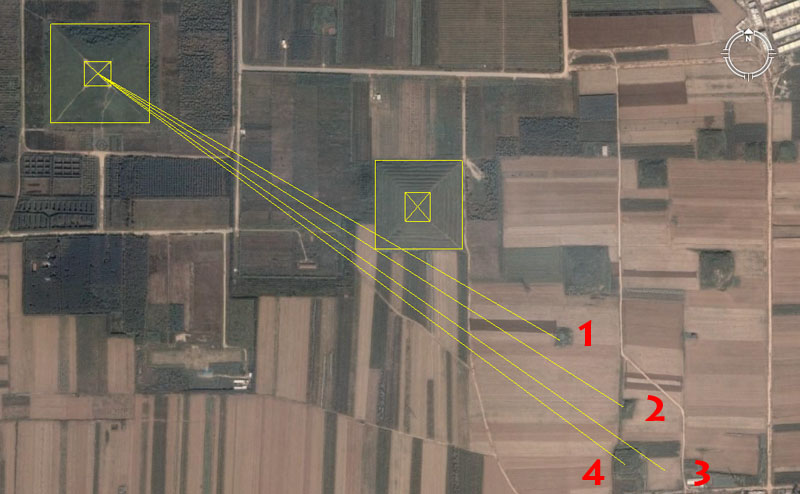
1. This pyramid sat 2916' feet out at an azimuth angle of 120°.
The values 2916 and 2916.666666 are lunar and navigational coding respectively. The Roman lunar Pace was 58.32" (2 X 29.16") whereas their overland Pace was 58.333333" (581/3rd"). Several ancient volumes were based around increases on 11.664 (1183/125ths ... the Roman lunar foot was 11.664"). From this concept there was yet another navigational system that considered the Earth to be 131250000 Roman feet in circumference.
The degree angle is 1/3rd of a 360° circuit.
2. This pyramid sat 3437.5 feet out from the main pyramid's surveying platform at an azimuth angle of 302.4°.
The 3437.5 value is navigational and relates to the equatorial circumference. There were two main systems encoded into the dimensions of the Great Pyramid and the literal one was based upon 24883.2-Greek miles of 5250' each. By symbolically elongating the Great Pyramid by 3", 1-minute of arc (6048') became 6050', for an equatorial circumference of 24750-miles of 5280'. This was the "11" system, adopted by Teutonic peoples and surviving into modern times in the British Isles and the United States (where it's still in use). Under the 24750-mile reading, 1-degree of Earth equatorial arc was 68.75-miles (34.375 X 2).
The degree angle is in homage to 3024', which was 1/2 of 1-minute of arc under the geodetic coding of the Great Pyramid. This very wrecked little pyramid at XI'an was undoubtedly for tutorials related to 1-degree of arc, based upon both the "6&7" (Greek mile) system and the "11" (British mile) system. A position on the top of the original pyramid undoubtedly marked an angle of 302.5°, as well as 302.4°.
3. This pyramid is almost totally ploughed over and eradicated now but appears to have sat 3780' out at an azimuth angle of 125°.
Again, the distance of 3780-feet is 5-times the length of the Great Pyramid or 5/8ths of 1-minute of equatorial arc.
The degree angle is accentuating the base 10 counting system.
4. This pyramid sat 3600' out at an azimuth angle of 126.5625° (1269/16ths).
The 3600' value is navigational and relates to the 360° compass.
The angle is lunar and relates to the lunar year, wherein 12.65625-days (1221/32nds ...303.75-hours) is 1/28th part.
THE CIRCLE MOUNDS TO THE SOUTHWEST
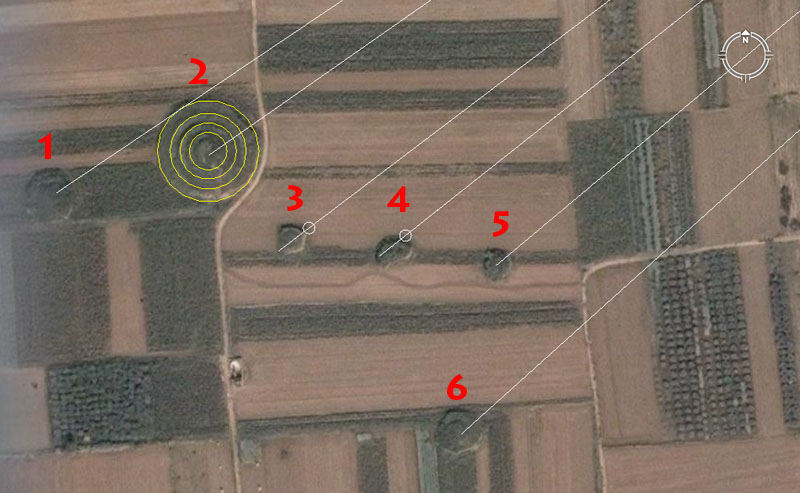
This mound complex, situated a mile from the main pyramid's surveying platform, was obviously a place of specialised navigational tutorials.
1. The distance from the main pyramid's surveying platform is 5500' and the azimuth angle return to the main pyramid is 56°.
This length contains a very important tutorial about navigation and the mathematical method employed for accurate positional plotting at sea. The same tutorial was encoded into the base dimensions of Silbury Hill in Wiltshire, England, where one cross measure (diameter) is 550'. What is being taught here is the "11" method of navigation:
(a). An "11" based diameter will generate a sexagesimal circumference (divisible by 360°) when PI is 1728/550 (3.141818182).
(b). The ancient British league (16500'), mile (5280'), furlong-furrowlong (660'), chain (66'), rod-perch (16.5'), fathom (5.5'), link (7.92"), were all "11" family lengths (divisible by "11"). All would convert to a sexagesimal circumference using PI @ 1728/550.
(c). The length of 5500' is 1/3rd of a league and was a perfect increment for sea legs, where one had to tack with the wind across a lay-line, then change tack to return back across the lay-line towards the destination. All ancient long-distance voyages under sail were a series of zigzag tacks using the available wind direction and it was mostly impossible to sail directly to a destination, unless the wind was blowing consistently in that exact heading.
(d). It was imperative for the navigator to know the exact degree angle around from north for each sea leg and to maintain a chosen heading until a predetermined "11" distance was fully covered. This could mean a part of a league or several leagues for any one sea leg. When the required distance was covered, the navigator would have the helmsman swing the boat to a new heading and have him maintain that for a set distance that was measurable by various means.
(e). At the completion of each leg, the navigator would mark the angle and distance just completed onto the sea chart or slate using a scale rule. He would then go to the end of the drawn line and create a circle, based upon the distance (diameter) covered by the leg. Because the leg was based upon the number "11", a scale rule would accurately show the navigator every degree of arc on the circle generated. By this means, the angle towards the destination or back to the point of departure could be known with considerable accuracy, as well as the boat's position within the featureless ocean.
(f). A sea leg diameter of travel of 5500' would generate a circle of 17280' (360 X 48'). A league of travel of 16500' would generate a circle of 51840' (360 X 144'), etc.
The above mathematical method allowed the Caucasian cousin nations to sail, thousands of years ago, to New Zealand, the most remote habitable country on Earth from the Mediterranean and Europe.
The degree angle introduces yet another navigational method used by the Greeks and Hebrew-Phoenicians. This was the "6&7" method of navigation, using a mile of 5250' (divisible by either 6 or 7). A diameter based upon 56 (7 X 8) will convert to an "11" series circumference using PI @ 22/7ths (3.142857143 ...31/7th). Therefore: 5600' X 3.142857143 = 17600' (31/3rd British miles). By consequence, a Greek mile of diameter converts to a circumference of 16500' (1-British league) using PI @ 22/7ths. Scale rules and calipers could then reduce such a circle into accurate readings of degrees of arc.
2. The distance is 5250' to the centre of the concentric rings and the return azimuth angle back to the main pyramid's centre-top is 55°.
In this instance we have the Greek mile of 5250' clearly marked into the Chinese landscape. The geometric earth embankment, set out in concentric rings, is very typical of what is found in Southern England, as elsewhere in Britain. This "bulls eye" configuration became a major emblem used by both the British and French military, as well as Teutonic nations, and has profound ancient meaning to those societies.
The 55° return angle reaffirms the fact that the Greek "6&7" based mile will generate an "11" series circumference. In other areas of the world, when the 5250' mile is displayed, generally the 5280' mile will be displayed alongside. The same holds true of the value 56 often being displayed alongside the value 55. When tutorial sites related to changing diameters into circumferences for positional plotting, such as this one, were set out, generally all of these principles were taught together.
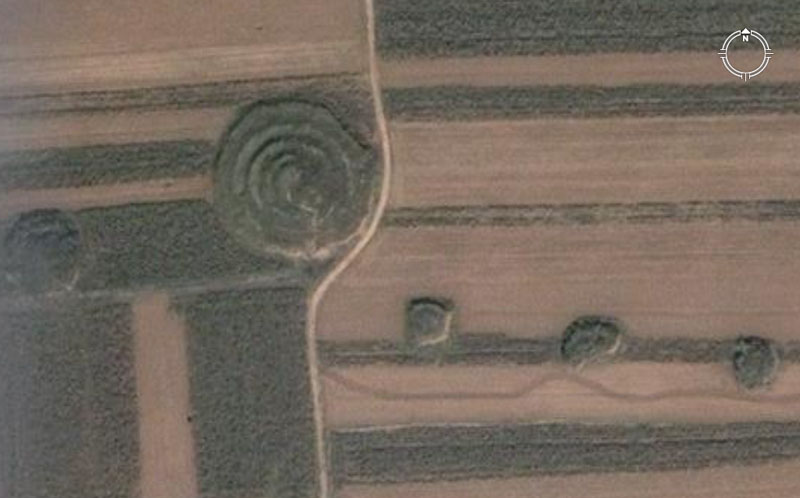
What's left of the ring-mounds for special tutorials related to navigation. The centre of the large concentric ring mound sits 5250-feet (Greek mile) from the centre platform of the main pyramid. The WSW embankment forming the innermost ring sits 5280' (British mile) from the pyramid. The concentric ring positions at the northern side flare approximately 1/4 of a degree at a time in relation to the top of the main pyramid.
The distance through the centre to the crown of the inner concentric ring bank is 5280'.
It's very probable that there were intense tutorials going on within this concentric ring complex to familiarise initiate students of the navigational arts methods of converting specialised navigational diameters to circumferences. Each ring would have related to a separate tutorial. By careful future measurements, we should be able to determine what each separate tutorial was per ring, but the overall diameter appears to have been 165'. This would have related to the ancient league of 16500' converting to a sexagesimal circumference of 51840' using PI @ 1728/550. The second inner circle appears to have related to a diameter of 168' converting to a circumference of 528 using PI @ 22/7ths. The third inner ring appears to code 84' converting to a circumference of 264' using PI @ 22/7ths.
Tutors would have applied many variations, both under the so-called Greek "6&7" system and the so-called British "11" system, the origins of which are very remote and undetermined. One variation to the outer diameter was, undoubtedly, to symbolically represent it as 161.80339' and, thereby teach about PHI ratio reductions. One such reduction would have been 61.804' (essentially the PHI reciprocal at enlarged ratio). The value 6.1804" was essential to the cousin Caucasian nations for the fabrication of precise volume tubs to be used in the market places when dispensing dry goods, such as grain, at very accurate cubic quantities.
3a. The distance to the ENE edge of this mound is 5184' from the pyramid platform and the azimuth angle is 52.8° return.
As mentioned, a British league of straight-line distance will generate a circumference of 51840' (360 X 144). The slope angle of the Great Pyramid of Egypt is 51.84°. The 25920-year duration of the Precession of the equinoxes = 5 X 5184-years. The speed at which the 24883.2-mile circumference Earth spins is 1036.8 MPH or 518.4 X 2, etc.
The degree angle @ 52.8° is in homage to the 5280' mile.
3b, The distance from the centre platform of the pyramid to the WSW side of this same mound is 5250', or 1 Greek mile.
4a. The distance to the ENE side of the mound is 5062.5' and the azimuth angle is 51.5625 (519/16ths) return.
This distance is lunar coding and a mathematical progression based upon 50.625 (505/8ths) with generate many useful lunar numbers. For example, the sum of 50.625-days is 1/7th of a lunar year.
The degree angle is navigational and relates to the "11" series Egyptian Royal Cubit of 20.625" . Under the "11" series way of reading the size of the Earth @ 24750-miles of 5280' each, the sum of 51.5625-miles would be 1/480th of the equatorial circumference.
4b. The distance from the pyramid platform to the WSW side of the same mound is 5120'.
This value is navigational coding. under the reading of 24883.2-miles for the equatorial circumference, the sum of 51.2-miles would be 1/486th part.
5. The distance is 4976.64' and the azimuth angle is 50° return.
This distance relates directly to the 24883.2-mile equatorial circumference of which 4976.64-miles would be 1/5th part.
The degree angle is, of course, simply accentuating base 10 of the counting system.
6. The distance is 5200 to the mound's centre and the return angle to the pyramid is 48°.
The 5200' value is in homage to the 52-week count of the solar year.
The 48 value can be pressed into service for all manner of calendar, precession of the equinoxes or navigational related calculations.
EPILOGUE.
XI'an was China's old capital city, where emperors reigned for about 3000-years. Many of these royal dignitaries, or others accorded the high honour, were buried in the pyramids of the district. Old Mongolian-Tibetan-Lama monastry records and oral traditions, however, attest to the fact that these pyramids were not built as mausoleums during the reign of the Chinese dynasties, but were considered to be old already 5000-years ago.
The pyramids seem to have been built at a remote epoch after the ice age, when several racial groups were crisscrossing this region of China, trading and settling or in transit to the Bering Strait and the Americas.
The complex of pyramids at XI'an form a typical "open air university", just like one finds at England's Avebury Henge or Stonehenge and their many outlying marker-mounds, as well as around the Octagon geometric earthworks of Newark, Ohio, USA or the Nazca lines of Peru and at Easter Island, etc., etc.
The same distance and angle codes recur at all of these sites around the world and all are related in terms of the specific information contained mathematically within each site. All display the same measurement standard or 360° compass pedigree, despite the fact that the open air university sites are scattered across several separate continents.
At a time when there appears to have been a lot of trans-continental migration going on, mariners or those traveling for vast distances by foot and horse drawn wagon, needed accurate means to explore, map and return to points of origin if they so desired. Vast new territories had opened up in the Americas with the melting of the Wisconsin ice shelf and there were verdant, virgin lands to occupy all around the world.
The pyramid complex at XI'an provided very sophisticated tutorials related to the size of the Earth and how to navigate around it safely. In the opinion of this researcher, based upon artefact and other evidence coming out of old Europe and Asia, these edifices could easily be up to 8000-years old.
To be continued.
Martin Doutré, December 16th, 2009 ©